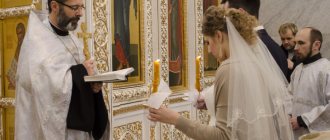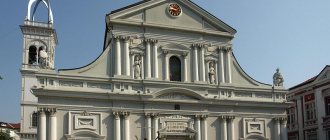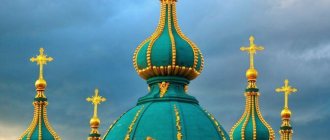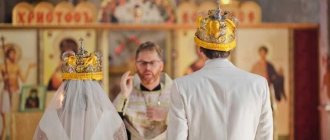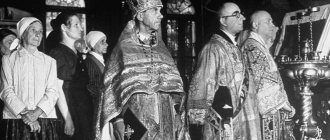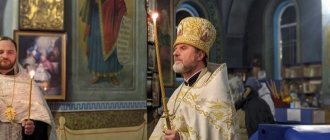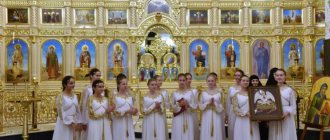What kind of service is this? Definition
The name of the service indicates that it should obviously take place at night. And the term “all-night vigil” speaks of the duration of prayers - until dawn. The Greek name for the service, “ἀγρυπνία” (“agripinia”), meaning both “sleeplessness” and “vigilance,” suggests the same thing.
Night prayers in the early Christian church
Indeed, the tradition of praying especially fervently during the night was known even among the first Christians. It goes back to the Lord Himself. The Gospels tell of His nightly prayers:
- before the election of the 12 disciples to the ministry (Luke 6:12);
- on the eve of the Transfiguration (Luke 9:28);
- before being handed over to the Jews in the Garden of Gethsemane (Matt. 25:36).
Useful materials
The Apostles often prayed at night. St. Luke talks about how St. Paul and Silas at night in prison “prayed and sang praises to God; and the prisoners listened to them” (Luke 16:25). The tradition of long night prayers gradually established itself among believers.
True, the vigil from sunset to dawn was performed by the first Christians only on special occasions, for example, on the eve of Easter. For the most part, prayers ended around midnight.
Monastic tradition
With the establishment of Christianity in Byzantium, long periods of prayer became the lot of monks, but not everywhere.
The 2 most common from the 6th-8th centuries are known. liturgical regulations of monks - Constantinople Monastery of St. Theodora (the monastery was also called Studio, named after the senator who once founded it) and the monastery of St. Savva the Sanctified near Jerusalem.
Based on their places of origin, these charters were called Studite and Jerusalem, and their attitude towards night prayers was different:
- monastery of St. Theodora was a dormitory, the monks lived under the direction of the abbot; long divine services were performed daily, no additional night vigil was required; but, like the first Christians, the Studians could perform similar services on the eve of major holidays;
- St. Savva was the spiritual leader of the hermit monks, who prayed in their cells throughout the week, only coming to the common church on the eve of Sunday; fathers who spent a week without Divine service needed spiritual reinforcement with especially intense prayer; Naturally, therefore, a long vigil on the eve of holidays and Sundays appears in the Jerusalem Rule.
In Russia
Russian liturgists at the beginning of the 20th century. It has been established that in Rus' three liturgical Rules successively replaced each other:
- introduced, apparently, under Prince Vladimir the Holy (10th century) Typikon of the Church of St. Sophia of Constantinople, the parish church, where the vigil was not provided;
- Studiysky, brought to Rus' under St. Theodosius of Pechersk (XI century); thanks to the high authority of the saint, it spread throughout the parish churches;
- Jerusalem, which appeared on Russian churches from the 14th century, when it spread to Byzantium; This monastic Charter of worship also extended to parish churches: there was no special charter specifically for secular churches in Rus' and does not exist to this day.
What does it mean
Among ordinary people, the most common name for this rite is all-night vigil. This type of worship can be held on the eve of especially revered church holidays. This ritual combines evening and morning services, which are held under greater illumination of the temple than on other days.
How long does the all-night vigil last? Initially, this procession got its name due to the fact that it began late in the evening and lasted all night until dawn. But later attention was drawn to the weaknesses of believers and the duration was shortened, but the name remained the same.
The best article for you, go to: The Twelfth Feast of the Theotokos: when is it celebrated, icons, how to arrange
Most often, the Divine Liturgy of the All-Night Vigil is held the day before:
- days of temple holidays,
- Sundays,
- holidays that are marked with a special sign in the Typikon,
- twelve holidays,
- any holiday at the request of the rector of the temple or regarding local traditions.
Features of this ritual:
- After Vespers, the blessing of wine, vegetable oil, bread and wheat can be carried out.
- Full observance of the all-night vigil involves reading passages from the Gospel during Matins, as well as singing a great doxology, in which a person thanks the Lord for the day he has lived and asks for help in protecting himself from sins.
- After the service, the faithful are anointed with oil.
How long does such a service last?
Thus, the appearance of the all-night vigil in Russia dates back to the 14th century. Over time, it turned out that the Russian service was much longer than that performed by Greek monks.
According to the Charter, the vigil begins at sunset and ends at dawn. But in Russian latitudes, the duration of the night is significantly longer, especially in winter.
Therefore, as modern liturgist A.M. points out. Pentkovsky, in order to extend the time of the service, added Compline, Midnight Office, and canons. This is how a statutory service lasting up to 8-10 hours was formed.
This is exactly how it was performed in Russian churches until the middle of the 17th century, when Patriarch Nikon carried out a liturgical reform. Since that time, although the Charter of this service has not changed, the practice has arisen of reducing it to a few hours.
All-night vigil
What services does the all-night vigil consist of?
Divine services are traditionally held on the eve of church holidays and Sundays. The composition of the All-Night Vigil is as follows: Vespers, Matins and the first hour. There are times when a service may begin with Great Compline, which will lead to Vespers. This scheme is necessarily used before Christmas and Epiphany. In some churches, after the completion of the service, the clergy conduct confessions, where people can repent of their sins.
"Historical Vigils"
At the beginning of the 20th century. Russian liturgists, professors of the Kyiv Theological Academy M.N. Skaballanovich and V.F. Pevnitsky, with the help of the clergy and students, organized the All-Night Vigil in full accordance with the Charter. This unique service began at 6 pm and ended around 2 am. M.N. Skaballanovich testifies:
“It is difficult to express in words how the listeners of this service, which someone called the “historic all-night vigil,” and especially its closest participants felt... Most of the performers of the service decided the next day that they had been drunk during the all-night vigil. There was no question of any fatigue. One singer stated that he could, without leaving the choir, sing another all-night vigil for God. One student, a lover of sleep, left the church several times, undressed, went to bed, but, unable to fall asleep from the thought that such an original, unheard of concert was taking place a few steps away, he returned to the church... Those acquaintances of the leaders who were not there notifications were sent about the upcoming all-night vigil, they almost quarreled with them because of this and took their word that if anything like this were repeated they would be notified. And repetition is possible..."
However, no one was able to repeat this experience for many years. Today, the full all-night vigil is constantly served only in Old Believer and Edinoverie parishes.
Some parish churches are also following the path of full implementation of the Charter. This is most consistently implemented in the Church of the New Martyrs and Confessors of Russia in Strogino (Moscow). Here since the early 2000s. On the initiative of the rector, Archpriest Georgy Krylov, a circle of Znamenny singing was created; parishioners studied ancient liturgical traditions for many years.
17
June
2011
Patriarch Kirill of Moscow and All Rus' blessed the rector of the church, Archpriest. George, to perform the all-night vigil in the old rite (which existed before the reform of Patriarch Nikon) every week, on Saturdays.
In simple words about the complex
The meaning of the word in Orthodoxy, how does it differ from evening worship?
In most Orthodox parishes in modern Russia, the all-night vigil consists of services running one after another:
- Great Vespers (on the eve of major holidays - Compline);
- Matins;
- First hour.
Such a service is performed on the eve of Sunday services, as well as before great holidays, days of remembrance of especially revered saints, patronal feasts of a particular church.
In addition, at the request of the rector, or according to local tradition, it can be performed on the eve of any other church celebration in memory of a particularly revered saint.
The difference between the all-night vigil and the evening service on weekdays is its greater solemnity and duration, since during it:
- as a rule, special proverbs (passages from the Old Testament) are read from the book in memory of a holiday or a great saint being remembered;
- lithium may be served and the consecration of the loaves may take place;
- as a rule, several canons are read;
- the believers are anointed with oil.
Duration on Saturday and other days
In most churches the service lasts about 2 hours; in monasteries its duration can increase to 3 hours. The service usually begins at 5 or 6 p.m.; the practice of praying throughout the night is now very rare.
Is confession allowed?
According to established practice, confession is usually held during the evening service. The all-night vigil is no exception.
At the same time, in small parishes where there are not enough clergy, the sacrament can be postponed until after the service, or the morning before the start of the liturgy. Therefore, it is better to find out the time of confession in a specific church.
Differences between the All-Night Vigil and Evening Worship
In Orthodoxy, the Evening Service and the All-Night Vigil equally occur on the eve of Sundays and holidays.
However, the evening service can begin at 16 or 19 hours and last until 21 or midnight, including only the first or second part of the All-Night Vigil.
But the All-Night Vigil, unlike Vespers, has two main parts: evening and morning, with the addition of 1, 3, 6 and 9 hours of worship, and begins at 17:00 until the morning.
Throughout the service, words of thanksgiving addressed to God are spoken. And the entire All-Night Vigil is permeated with a reminder of who is a man and who is the form of a beast that has not realized its actions. This is the meaning of the All-Night Vigil, to understand yourself and your actions, and, having realized, to repent and draw closer to the Lord.
Components with explanations
Parts of the service symbolically depict the path of humanity, the history it has traversed from the creation of the world to the Incarnation of Christ.
Vespers
The first exclamation of the priest that opens it is “Glory to the Holy, and Consubstantial, and Life-Giving, and Indivisible Trinity...”. This is the glorification of God for creating the world. Then the priest walks around the church with a censer, while the choir sings Psalm 103, dedicated to the beauty of the world, which God “with wisdom created.” Thus, believers are called to remember Paradise, where He Himself was in communion with Adam. It is not for nothing that during censing the gates to the altar are open, symbolizing the unity of the Creator and His creation.
At the end of the censing, the gates are closed. The petitions that the deacon pronounces before them are the cry to God of a sinned person deprived of Paradise.
Old Testament verses of repentance are also sung, and then Sunday hymns, or the celebrated event. The last of them is always dedicated to the Mother of God, thanks to Whom Paradise became possible again for people.
After this singing, the royal doors open and the evening entrance of the priest and deacon takes place during the hymn “Quiet Light of Holy Glory...” dedicated to Christ.
An important moment of the service is the proverbs read on major holidays - excerpts from the prophetic and other Old Testament writings, prophetically predicting the celebrated event.
Lithium
This service takes place on major holidays. The clergy usually proceed from the altar to the middle of the temple or closer to the entrance, and make special prayers for the believers, the Church.
In the first centuries of Christianity, it was customary to go out to the litany in the vestibule, where the penitents who were not admitted to the sacraments stood, so that they could participate in the general worship.
According to the litia, the priest blesses 5 loaves, oil, wine, and wheat. Nowadays this is understood as a remembrance of the Lord feeding 5,000 people in the desert with five loaves.
Interesting fact
In ancient times, the rite also had a practical meaning: after the litia, bread was distributed to pilgrims and other pilgrims who came from afar.
Vespers ends with the reading of the prayer of St. Simeon the Receiver of God, uttered by him at the Meeting of the Lord (“Now dost thou let thy servant go, O Master...”) and the prayer “Virgin Mother of God, rejoice...”, which marks the Incarnation of Christ.
Matins
This service is all dedicated to Christ. It begins with the words of the Angel’s greeting, which at one time announced to the shepherds about the Birth of the Savior: “Glory to God in the highest, and on earth peace, good will toward men.”
Six Psalms
Then the lamps and all the candles are extinguished. Going out to the middle of the church, the sexton begins 6 psalms, which form the Six Psalms and depict the misfortune of man, the expectation of God's help.
St. Pasisy Svyatogorets says:
“The Six Psalms symbolizes the Last Judgment. Therefore, it is good if, while reading the Six Psalms, the hour of the Last Judgment comes to mind. After the first article (the first three psalms), we do not even get baptized, because Christ will not come now to be crucified, but will appear to the world as a Judge.”
After the Six Psalms, the deacon pronounces a litany (prayer requests), and a kathisma from the Psalter is read.
Polyeleos
Then comes the most solemn moment of Matins - after the incense of the church, the Gospel is read, and then the polyeleos begins: the believers, while reading the canon of a holiday or a saint, are anointed with oil consecrated at the litany.
The service ends with the singing of “praise” psalms and stichera glorifying God. The culmination is the Great Doxology, which begins with the exclamation “Glory to Thee, who showed us the light!” In ancient times, when prayer was performed all night, by this time the sun had risen, all believers glorified the coming of a new day.
First hour
At the end of Matins, a sequence of 1 hour is performed, during which God’s blessing is asked for the new day. This short service includes:
- Psalms 5, 89, 100;
- prayers dedicated to the Mother of God and troparia for the celebrated event;
- closing prayers.
How does the all-night vigil work?
Such worship can free a person’s soul from negativity and bad thoughts, and also dispose him to accept gifts of grace. The all-night service symbolizes the history of the Old and New Testaments. There is a certain structure for conducting worship.
- The beginning of the all-night vigil is called Great Vespers, which serves as a depiction of the main Old Testament stories. The Royal Doors open and the creation of the world by the Holy Trinity is celebrated.
- After this, a psalm is sung, which glorifies the wisdom of the Creator. During this, the priest censes the temple and the believers.
- After the closing of the Royal Doors, which symbolizes the commission of the first sin by Adam and Eve, the prayer is performed in front of them. The verses “Lord, having cried to You, hear me” are sung, which remind people of their plight after the Fall.
- The stichera dedicated to the Mother of God is read, and during this the priest leaves the northern doors of the altar and enters the Royal Doors, which personifies the appearance of the Savior.
- The structure of the All-Night Vigil implies a transition to Matins, which signifies the advent of the time of the New Testament. Of particular importance is the polyeleos - the solemn part of the service, during which the mercy of the Lord is glorified for the gift of the Savior.
- The Gospel dedicated to the holiday is solemnly read and the canon is performed.
Features for the Presentation of the Lord
Meeting is the twelfth holiday, which may coincide with the time of preparation for Great Lent, as it is celebrated in February. The Charter contains various liturgical instructions about the peculiarities of the all-night vigil for this holiday in such cases.
When Candlemas coincides with the days when the Lenten Triodion is sung, at the festive vigil one can hear repentant chants, preparing believers for fasting. But if Candlemas falls on the 1st day of Great Lent, then the service is moved to the previous Sunday, respectively, the vigil falls on the Saturday before.
